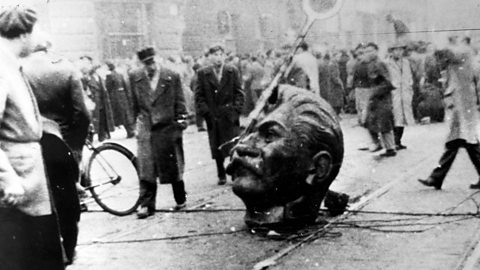The Hungarian Uprising, 1956

In November 1956, Soviet tanks invaded Hungary - a country that was already under its control. The Hungarian people took to the streets and to fight the Soviet Red ArmyArmy of the USSR.
Why were the Hungarian people unhappy and what were they fighting to defend?
- Although non-communists won the 1945 election, by 1948 the communists had taken over by taking control of the secret police (the AVH) and eliminating their political opponents. The Hungarian leader, Matyas Rakosi, was a hard-line communist fully in league with Moscow.
- Hungarians had no freedom of speechThe belief that humans have an absolute right to voice their opinion publicly without censorship or punishment.. The AVH created a climate of fear, arresting anyone who spoke out against communismA classless society where all property is owned publicly.. Even something as simple as listening to Western music could lead to arrest.
- Thousands of Soviet troops and officials were stationed in Hungary, which were a drain on the Hungarian economy, creating economic hardship for ordinary people.
- The Russian language was being forced upon the people - with Hungarian street signs being replaced with Russian versions, and Russian being imposed as the language in schools.
In February 1956, the new Soviet leader, Khrushchev, made an important speech to leading communists at a closed meeting. This has become known as Khrushchev’s ‘secret speech’ but what he said did not remain a secret. He denounced many of Stalin’s crimes and human rights abuses and outlined his de-StalinisationReforms initiated by Krushchev after Stalin’s death to denounce his influence and make Soviet society less repressive. policy – that is that he would be less hard-line than Stalin had been and would use diplomacy, not force, in his dealings with other governments. This encouraged people in the Eastern BlocThe communist countries of eastern and central Europe that were dominated by and allied with the Soviet Union after World War Two. to think that greater freedoms might be possible.
The speech had an impact in Hungary. In June 1956 the Hungarian people began to protest against Rakosi’s regimeThe leadership or people in charge of a country. and he was replaced with Erno Gero. Gero was no more popular and, following huge demonstrations, the Soviets agreed to the formation of a new government under the more liberalThese are believers who are willing to make changes to religious beliefs and practices to keep in line with changes in the world. reformer Imre Nagy.
Nagy’s reforms included:
- Free elections to choose the government.
- An impartial legal system to ensure fair trials.
- The total withdrawal of the Soviet army from Hungary.
- Farmers to be allowed private ownership of their land (instead of it being state owned).
- Hungary to leave the Warsaw PactA collection of 12 communist countries that agreed to defend each other if one of them was attacked. and declare neutralityNot supporting one side or another, staying out of a conflict. in the Cold War.
The Soviet crackdown
Khrushchev refused to accept Hungary leaving the Warsaw Pact as it would leave a gap in the USSRUnion of Soviet Socialist Republics - collection of states, also known as the Soviet Union. buffer zoneAn area giving someone protection against a threat, e.g. the USSR wanted a buffer zone around them after being invaded by Germany in both World Wars. with Western Europe.
Thousands of Soviet tanks and soldiers entered Hungary to crackdown on the protests. Many Hungarians tried to flee but were blocked from leaving the country; others were killed or injured. Many thousands of Hungarians were arrested and 26,000 Hungarians were tried with additional imprisonments and executions as a result.
Nagy was arrested and executed. He was replaced by János Kádár who crushed the remaining resistance.
The international reaction to the attempted revolution indicated that, despite its declaration that it would roll-back communism, the countries of NATOA military alliance of western powers that was originally created to provide a counterforce to the Soviet armies of Eastern Europe. were unwilling to intervene in Soviet bloc countries.
The UN declared its disgust at the treatment of Hungarians by their government, and aid money was raised for the refugees. Communist parties in some Western European countries like Italy, Britain and France, began to change their opinion of the USSR. However, there was no military intervention to support the Hungarian rebels.